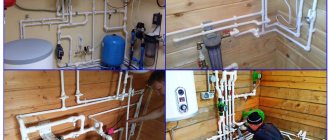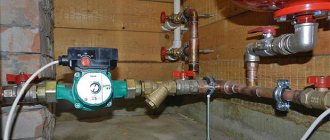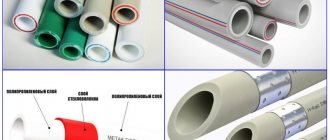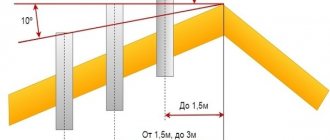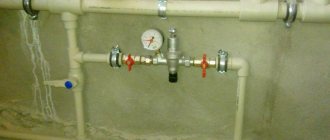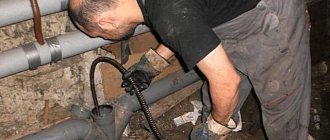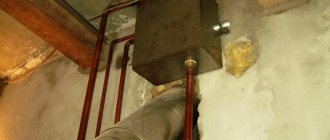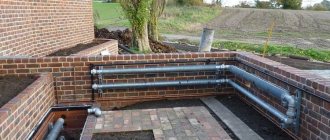Comfortable living conditions are ensured by a powerful system of various engineering communications. When planning heating in a private house, it is necessary to correctly calculate not only the parameters of the boiler, but also the elements for transporting the coolant. In this review we will look in detail at how to choose the diameter of a heating pipe.
- Convection
- Two-pipe
- For two-pipe version
Effect of characteristics on efficiency
A well-designed pipeline design has a positive effect on the performance of the heating system. The throughput of the structure depends on the cross-section of the components. The parameter shows the volume of hot liquid that will pass at a constant speed per unit of time.
Utility network performance is often influenced by factors. The efficiency of the circuit depends on 4 circumstances:
- Throughput and heat dissipation. The characteristic depends on the amount of water in the system.
- Pressure. The parameter in the heating network is associated with temperature and speed.
- Heat loss. At the joints and on the bends there will be a decrease in performance.
- Noise. The faster the fluid moves, the louder the sound.
In a heating system, with a constant flow of coolant and a decrease in diameter, the rate of water movement increases. On lines with a small cross-section, the fluid velocity will increase. Due to the low pressure in large structures, the flow rate is reduced.
Heat pipe diameterSource mastergrad.com
If the diameter of the pipes for heating a private house is too large, then the power of the pump built into the boiler will not be enough to move it. In a large system there will be a lot of coolant, so the equipment will not be able to cope with the movement of such a volume of liquid. Heating excess water will require spending more energy and time, which reduces the efficiency of the network and increases losses. As moisture passes through all rooms, it cools quickly.
The overall section is prohibited from being used in systems with natural circulation. When the speed is reduced, there is a risk of stopping and boiling the liquid in the heating boiler. With a small diameter, moisture can rupture the utility network.
What does the size of parts affect? Source ekaterinburg.kassot.com
When the speed decreases to 0.25 m/sec, air pockets often appear in the pipes. If the flow speed is more than 1.5 m/sec, then noise appears in the heating system. If the background noise standards are constantly exceeded, the inhabitants of the cottage will find it uncomfortable to live.
Installation of heating devicesSource realstroyservis24.ru
Heating manifold calculation
To ensure balance and stable operation of the heating system, all its elements must match each other in their throughput. The latter depends on the correctly selected pipe cross-section.
The reservoir calculation is based on this principle. It must have a cross-sectional value equal to or permissibly larger than the sum of the cross-sectional areas of all outlet branches. The cross-sectional size of the prefabricated comb must be no less than the sum of the areas of the supply pipelines.
This condition is described by this formula:
S = S, + S,, + S,,, + … + Sn
Where:
- S is the cross-sectional area of the collector or comb;
- S, ... - Sn - cross-sectional areas of outgoing or incoming branches.
Formula for calculating cross-sectional area
The basis is the formula for calculating the area of a circle, and in this case, the cross-section of the collector (comb). The sum of the cross-sectional areas of the outgoing pipes gives the desired result - the size of the heating collector.
Scall = π × Dcall²/4, then the calculation formula takes the form:
π × Dcol²/4 = π × d,²/4 + π × d,,²/4 + π × d,,,²/4 + …+ π × dn²/4,
Where:
- Dcol — collector diameter;
- π—pi number;
- d, — dn – internal diameters of outlet branches.
To simplify the formula, you need to reduce the number pi and take everything to the square root:
Dcall = 2 × √ (d,²/4 + d,,²/4 + d,,,²/4 +…+dn²/4).
Using this formula, you can calculate a reservoir of any complexity and configuration. If all outgoing heating branches have the same diameter, the formula takes the following form:
Dcall = 2 × √ (dtotal²/4 × N),
Where:
- N is the number of pipes leaving the comb;
- dtotal – diameter of each outlet pipe.
If the calculation results in a fractional number, it should be rounded up. This is necessary to avoid narrowing the cross-section of the collector and reducing the power of the system.
Additional requirements for collector design
When calculating all parameters of the collector, two conditions must be met: the distance between the input and output groups of branches is equal to six diameters, and the heating circuit outlets are three sizes apart from each other.
Scheme for connecting the collector to the cottage heating system.
Types of pipes
The selection of the diameter of the heating pipe depends on the material from which the elements are made. The parameters affect not only the cross-sectional dimensions, but also the installation method, the cost of the project and possible heat loss. For heating systems, 4 popular types are used.
Steel
Metal pipes when creating utility networks are an inexpensive and practical option, which have high thermal conductivity and a maximum pressure of up to 30 atmospheres. With proper use, the structures will last 20-30 years. The raw material has no temperature restrictions, so it is often used in a steam system at 100-130 C.
Due to cost and resistance to expansion, property owners often choose carbon steel. Corrosion is the main disadvantage of metal models. During oxidative processes, roughness appears on the surface of the walls, on which deposits accumulate. As plaque grows, the passage for water decreases and the thermal conductivity of the product decreases. When the walls become thinner due to rust, breakouts form. The problem can be minimized by using high-quality coolant in the system and regular flushing of pipes.
Carbon modelsSource x-teplo.ru
Galvanized steel is a little less capricious. The coating protects the metal from corrosion, thereby increasing the service life of the utility network. The models can withstand loads during water hammer and function perfectly in high temperature conditions.
Stainless steel pipes are superior in durability to galvanized and carbon types. A properly installed structure is inert to aggressive coolant, therefore it is not afraid of corrosion and will last more than 30 years. Elements made by seamless welding are suitable for the heating circuit.
Stainless steel optionsSource ovknn.ru
The disadvantage of all steel pipes is the weight and complexity of installation. Structures do not bend without special equipment, so at bends it is necessary to use additional parts that reduce the efficiency of the utility network. Now there are options in the form of corrugation, but they are also unstable to the aggressive environment of coolants.
Copper
The maximum operating temperature is 200-250 C, pressure is more than 30 atmospheres. If installed correctly, the heating system will last 90-100 years. The metal has high resistance to corrosion and freezing. According to production technology, copper pipes are divided into 2 types:
- Unannealed. Very strong material will not crack under pressure up to 40 atmospheres.
- Annealed. After heat treatment (annealing), the products become elastic and flexible, while their strength decreases.
Compared to steel, copper has a high density, so the pipes have thin walls and are light in weight. Due to good thermal conductivity, the circuit heats up quickly and evenly. Thanks to the flat surface, the circulating fluid has minimal resistance. There are no growths on the internal partitions, which eliminates the appearance of blockages and a decrease in efficiency.
Heating solution made of metalSource otoplenie-doma.in.ua
Copper pipes are not compatible with other metals. Upon contact with steel, aluminum or cast iron, chemical processes begin in the liquid and gas is formed. The utility network must provide bleed valves for accumulations. Additional parts should be made of copper or brass, radiators should be made of stainless steel.
In a heating system with copper pipes, a well-purified coolant is used. Solid debris can damage soft metal. Additionally, a mechanical cleaning filter is included in the network. The material has high electrical conductivity, so the circuit must be grounded.
Metal structures for a cottageSource kenoll.ru
Polymer
The maximum temperature of the coolant varies between 90-95 C. The structure will withstand 130 C for a short time, but with prolonged contact the polymer pipes are deformed. If the operating rules are followed, they will last up to 30 years. When connected to heating, the circuit is resistant to pressure surges.
Due to the plasticity of the material, pipes are easy to lay without cutting and without additional connections. For welding, a special apparatus is used that heats the parts. The soldering points in the finished structure are not visible to the naked eye.
Plastic models for a private homeSource teplomir.in.ua
Plastic is not demanding on the quality of the liquid in the heating system. The raw material does not enter into a chemical reaction, therefore it does not rust or be destroyed by corrosion. Ideally smooth walls do not reduce the speed of the coolant and are not covered with plaque.
Reinforced polymer pipes are used for heating, which can be identified by markings on the surface (PPR-FR-PPR, PPR-GR-PPR). The reinforcing material is fiberglass or aluminum.
Heating solutionSource oboiman.ru
Metal-plastic
The pipes consist of 5 layers of modified plastic and thin foil, so they are very durable. The products are resistant to high temperatures (up to 110 C), freezing and thawing, and retain their original shape. Due to the smoothness of the inner walls, deposits do not form on the surface.
In terms of linear expansion, metal-plastic pipes are 2.5 times higher than their steel counterparts. With prolonged exposure to direct ultraviolet and electromagnetic rays, the product quickly loses strength and wears out. Parts must be installed correctly and connections must be tightened tightly. When the bending angle is exceeded, they crack.
Mounting sleeves
Installation of the heating system is impossible without the use of mounting sleeves. When laying a pipeline through walls and ceilings, the walls of the products come into contact with an aggressive environment.
Due to physical laws, pipes during operation will undergo periodic contraction and expansion. This will lead to mechanical stress on the surface, guaranteeing faster wear at the contact points. To avoid this, SNIP building codes provide for the supply of pipelines with additional structural parts called sleeves.
The sleeves are designed to:
- prevent the leakage of liquids from adjacent rooms or the street;
- prevent the passage of unnecessary gaseous substances;
- maintain sound insulation;
- ensure the integrity of the structure when dismantling or replacing the pipeline;
- prevent unwanted insects from entering the premises.
The pipeline can pass through any building in two planes: vertical (floors, floors, ceilings) and horizontal (internal and external walls, ceilings).
The sleeve consists of:
- Covers (standard or cut from steel or polymer pipes).
- Packings (filling the cavity between the pipeline and the cover), which can be a soft, non-combustible material. It is possible to use special cement or clay mixtures.
The size of the sleeve assembly is determined by the outer diameter of the pipeline and the thickness of the wall or ceiling: the size of the sleeve and the length of the product should be 10–20 mm larger.
This video will briefly introduce you to the installation of a heating system in an apartment.
General information about heating pipes
All pipes for heating systems can be divided into two types: metal and polymer.
Metal:
- copper;
- metal-plastic;
- bronze;
- metal corrugated;
- steel.
Copper pipes are superior to all others in the following parameters: long service life, smoothness, which increases the speed of coolant movement, and resistance to ultraviolet radiation.
Polymer:
- polyvinyl chloride (PVC);
- polyethylene terephthalate (PET);
- metal-plastic;
- polyurethane;
- propylene;
- polypropylene.
The cross-sectional diameter in which propylene and polypropylene pipes are offered can be in the range of 16-110 mm. The advantages of this material include: relatively low weight, ease of processing and installation work, low price. Long-burning wood stoves for home heating you will find the answer in the link.
What diameters are there?
In the technical parameters of heating pipes, different types of sections are used. When taking into account the mounting structures and the occupied area, take the outer diameter with the walls. Internal characteristics indicate the size of the gaps, therefore they are suitable when calculating network throughput. The conditional version is an averaging to the larger side of the space inside.
In stores, pipes are marked by their outer cross-section, often in inches (25.4 mm). Internal parameters vary depending on the wall thickness, material and purpose of the part. The external characteristics of steel seam models are 3-4% thicker than those of polymer and seamless structures. Copper types are the thinnest, 1-2 mm smaller than others.
Analysis of popular typesSource alchevsk.ua
The size of the heating pipes affects the tasks that the element must perform. Popular diameter parameters range from 16 to 40 mm:
- 16. Used to connect one or two batteries.
- 20. Suitable for installing 1 radiator or a group of up to 5 pieces. The total maximum power is 7 kW.
- 25. Models are used for installing heating structures with dead-end wiring diagrams.
- 32. Used for arranging the utility network of an entire floor or cottage, with a total capacity of up to 19 kW.
- 40. Suitable for 20 batteries, up to 30 kW.
The choice of cross-section of heating pipes determines the throughput capabilities of the system, hydraulic and heat losses. The bulk coolant heats up quickly, and the small size provides better resistance and low noise. Elements of small diameter are cheaper than large ones. Models that are too compact create increased load on the reinforcement, which leads to gusts.
Features of calculating the cross-section of metal pipes
Heating systems made of metal pipes must take into account the coefficient of heat loss through the walls. This is especially important with a significant pipeline length, when heat loss on each linear meter can have catastrophic consequences for the final radiators.
| Metal | Thermal conductivity coefficient, W/(m×deg) |
| Steel | 45,4 |
| Cast iron | 62,8 |
| Copper | 389,6 |
| Brass | 85,5 |
By adding a power reserve to the power system and choosing the correct pipe diameter, it is possible to prevent significant heat leaks.
Types of coolant movement
The speed of movement of the hot water flow in the pipes is one of the important parameters that allows you to calculate the diameter of the parts. The recommended movement ranges from 0.26 to 1.4 m/sec. Already at 1.5, heat transfer decreases and noise in the utility network increases. There are 2 types that you need to understand.
Pipe size optionsSource prootoplenie.com
Convection
The natural circulation option is suitable for solid fuel boilers. The operating principle is based on physical laws. The density of a cold liquid is less than that of a hot one. Cool moisture flowing down the pipe displaces warm moisture upward. The speed of movement in such networks is 0.2 m/sec.
A small flow of movement during convection circulation causes the formation of air jams and a decrease in the volume of transferred heat. The expansion tank and Mayevsky taps will help solve the problems.
System with convection movementSource aniko-gas.ru
The diameter of the heating parts with convection circulation must match the boiler outlet pipe. The largest starting section is maintained until the first fork. When laying, the size of the pipes is gradually reduced. In the last node, the characteristics of the elements vary between 16-19 mm.
Forced
Circulation in the circuit is carried out using a pump and a manifold, which are included in the design of the boiler (gas, electric). The user can independently control the speed of the coolant. In engineering networks, parameters are maintained within the range of 0.7-1.2 m/sec.
In options with forced circulation, it is advisable to use pipes of small diameter. In a circuit with a small volume, it is faster and easier to heat water, which increases the efficiency of the design. Installing and masking thin parts is much easier than thick counterparts.
Forced circulation in the systemSource eco-kotly.ru
The cross-section of networks with forced circulation often depends on the heating connection diagram. The size for radial connection from equipment to pipes is 19 mm, for single-pipe and double-pipe - 25 mm. The parameter is not final and is calculated based on the characteristics of the boiler and cottage.
How much heat should the pipeline supply?
Let's take a closer look at the example of how much heat is usually supplied through pipes, and select the optimal pipeline diameters.
There is a house with an area of 250 sq. m., which is well insulated (as required by the SNiP standard), so it loses heat in the winter by 1 kW per 10 sq. m. To heat the entire house, 25 kW of energy is required (maximum power). For the first floor - 15 kW. For the second floor - 10 kW.
Our heating scheme is two-pipe. One pipe supplies hot coolant, and the other pipe cools it to the boiler. Radiators are connected in parallel between the pipes.
On each floor, the pipes branch into two wings with the same thermal power, for the first floor - 7.5 kW, for the second floor - 5 kW.
So, 25 kW comes from the boiler to the interfloor branch. Therefore, we will need main pipes with an internal diameter of at least 26.6 mm so that the speed does not exceed 0.6 m/s. A 40mm polypropylene pipe is suitable.
From the interfloor branching - along the first floor to the branching on the wings - 15 kW is supplied. Here, according to the table, for a speed of less than 0.6 m/s, a diameter of 21.2 mm is suitable, therefore, we use a pipe with an outer diameter of 32 mm.
7.5 kW goes to the wing of the 1st floor - an internal diameter of 16.6 mm is suitable, - polypropylene with an outer diameter of 25 mm.
For each radiator, the power of which does not exceed 2 kW, you can make an outlet with a pipe with an outer diameter of 16 mm, but since this installation is not technologically advanced, the pipes are not popular; a 20 mm pipe with an inner diameter of 13.2 mm is more often installed.
Accordingly, we use a 32mm pipe on the second floor before branching, a 25mm pipe on the wing, and we also connect the radiators on the second floor with a 20mm pipe.
As you can see, it all comes down to a simple choice among the standard diameters of commercially available pipes. In small home systems, up to a dozen radiators, in dead-end distribution circuits, 25 mm polypropylene pipes are mainly used - “per wing”, 20 mm - “per device”. and 32 mm “to the main line from the boiler”.
Heating systems
To correctly calculate the diameter of the pipes, you need to take into account the wiring diagram. Resistance affects the parameters of heating equipment and the characteristics of parts (section, material). The cottage uses 2 types of heating systems.
Two-pipe
The heating option with a vertical riser for the placement of pipes can be either upper or lower. Two elements are connected to each radiator: for supplying hot moisture and removing cold moisture. Horizontal wiring is:
- dead end;
- parallel;
- radial (collector).
The maximum temperature for polymers is 95 C, for steel – 130 C. A long utility network with a large amount of coolant works only with forced circulation. Understanding which circuit you are using, it is easy to calculate the total length, speed delays at the joints (bends) and obtain the required resistance.
Advantage of the scheme in a cottage Source 1-teplodom.ru
Proper selection of the diameter of the heating pipe will ensure uniform heating of the batteries. Professionals often prefer polymer parts with a cross section of 25 and 20 mm. Large elements are used as a circuit, smaller ones are used as outlets to radiators. In a compact private house, the main network is assembled from 20 mm, the pipes are made from 16 mm.
Knowing the number of square meters of housing, it is easy to determine the power of the heating equipment and the diameter of the pipes. In a boiler with high productivity, elements with a large cross-section are used. To heat 1 m2 with ceilings of 2.5 m, you need 100 W of equipment intensity. Possible heat losses relevant for a particular region are added to the parameters.
Option with top linerSource eco-kotly.ru
The fluid speed in the pipes should vary from 0.25 to 1.3 m/sec. If the boiler has a built-in pump, then take the average flow value (0.6 m/sec). When choosing a cross-section, the cooling time of the water is taken into account, which on average is 20 C. For heating equipment with a pressure of 10 atmospheres, parts with a cross-section of 25 mm are suitable, for powerful structures of 20-25 - 32 mm.
Single-pipe
In small cottages they use the Leningradka scheme. The system consists of 1 pipe to which all radiators are connected in series. The heating circuit operates in cyclic mode. The equipment supplies hot coolant from the boiler to the batteries, and returns the cooled coolant to the apparatus for heating. The maximum temperature for metal elements is 105, for plastic - 95 C.
A one-pipe system necessarily includes devices called a safety group. Additional devices allow you to quickly reduce the increased pressure in the network, preventing pipe rupture. During installation, components are placed as far as possible from one another. The safety valve is installed just above the boiler. Temperature regulators and Mayevsky taps are installed evenly throughout the entire circuit.
Why is the scheme better Source kupisantehniki.ru
With natural rotation, water moves by gravity through the system, with forced rotation - with the help of pumps. To ensure a balanced design, the cross-section of parts in a single-pipe network often differs in different areas. If the house is one-story and compact, then components with the same diameter are taken. In tiny rooms, even with convection circulation, the size of the elements should not exceed 32 mm.
Single pipe designSource 1-teplodom.ru
Two-pipe circuit in a high-rise apartment
To properly install heating in an apartment in a multi-story building, you need to plan everything from the beginning. One of the key points when planning is calculating the diameter of the heating pipe. The technical part of the matter is called hydraulic calculation. In this case, the choice of the diameter of heating pipes is influenced by the following factors:
- length of the system;
- supply coolant temperature;
- return coolant temperature;
- materials and accessories;
- room area;
- degree of fatigue in the room.
In other words, before calculating the diameter of the heating pipe, you need to determine the hydraulic parameters of the system. You can only make approximate calculations on your own, which can also be used in practice.
Sealed two-pipe system
The diameter of the pipes for a two-pipe heating system directly determines how quickly the heat from the boiler will reach the end point of the circuit. The smaller the nominal diameter, the higher the coolant speed. Based on this, we can conclude that if the diameter of the heating pipe in the apartment is chosen incorrectly, the speed of the coolant will drop, and along with it the temperature in the last radiator will be lower. After all, water will have time to give off more heat over a longer period of time.
The simplest solution for calculating the diameter of a heating pipe is to adhere to the same nominal passage as in the pipe extending into your apartment from the central riser. This will save you time and nerves, because it is no coincidence that the developer installed a contour with exactly this cross-section. Before the construction of the facility began, all calculations were carried out, including hydraulic ones. If you want to calculate everything using the formula, then use the information from the next block.
The optimal pipe diameter for heating in an apartment and in a private house up to 100 sq. m is 25 mm. This applies to products made of polypropylene.
Boiler power
In a country house, rooms are heated using gas or electric equipment, less often - solid fuel models. Based on the size of the heated space, the power is calculated. For high-quality home heating you need 0.1 kW of thermal energy per square. Parameters may change due to climatic conditions or gentle regime up to 1.3.
The power of the boiler is affected by the material from which the walls are made and the presence of thermal insulation. Increased thermal conductivity, combined with the thinness of the partitions, increases the heat loss of a country house. Even the most efficient model will not cope with heating the building.
What to look forSource eco-kotly.ru
The quality of heating is affected by the presence of a second circuit in the boiler. When hot water is turned on for domestic needs, the performance in the utility system decreases. Designs with this option should have higher parameters than their single-circuit counterparts.
The boiler power depends on the type of fuel. Gas equipment is considered the most practical. The most expensive are electric, the most inconvenient are solid fuel. Pumps are used to optimize coolant circulation and solve the problem of air locks.
Optimal size, temperature and pressure
When installing a small heating circuit of a standard type, some recommendations from experts will allow you to do without complex calculations:
- For pipelines with natural circulation of the carrier, it is recommended to use pipes with an internal cross-section of 30-40 mm. Increasing the parameters threatens with unreasonable coolant consumption, a decrease in the speed of its movement and a drop in intra-circuit pressure.
- Too small a pipe diameter will cause an overload inside the line, which can cause it to break through at the connecting elements.
- To ensure the required speed of movement of the coolant and the required pressure inside the forced circulation circuit, preference is given to pipes with a cross-section of no more than 30 mm. The larger the cross-section of the pipe and the longer the line, the more powerful the circulation pump is selected.
Important! Arrangement of an effective heating system involves the use of pipes of different sections in different sections of the main line.
The operating pressure level of the circuit must not exceed the stability limit:
- heat exchanger built into the boiler (max - 3 atm or 0.3 MPa);
- or 0.6 MPa (with a radiator circuit).
The optimal value for heating systems with a circular pump is considered to be in the range from 1.5 to 2.5 atm. Under natural circulation conditions - from 0.7 to 1.5 atm. Exceeding the standard will inevitably cause an accident. To control the pressure level in heating systems, expansion tanks and pressure gauges are installed.
Autonomous heating allows you to regulate the temperature of the coolant yourself, depending on the season and the individual needs of the residents of the house. The optimal temperature is considered to be in the range from 70 to 80⁰C, in steam heating systems – 120-130⁰C. The best solution would be to use gas or electric boilers, which allow you to control and regulate the heating of the circuit, which cannot be said about solid fuel equipment.
The design features of heating systems also determine the temperature conditions:
- the maximum heating of the carrier in a single-circuit wiring is 105⁰C, in a double-circuit wiring - 95⁰C.
- in plastic pipelines the carrier temperature is limited to 95⁰C, in steel pipelines - 130⁰C.
The temperature difference between supply and return is 20⁰C.
How to use tables
If you don’t know what diameter of pipes is needed for heating a private house, you can use the tips. Manufacturers have developed special tables to help calculate the required parameter. The size depends on the heat volume, hot water speed and degree.
For two-pipe version
For clarity, let’s consider calculating the cross-section of pipes for heating a cottage consisting of two floors. Polypropylene models are used for the circuit, and the boiler operating mode is 80/60 with a temperature difference of 20 C. The heat loss of the building is 38 kW. It takes 20 kW to heat the lower rooms, and 18 kW for the upper rooms. In the tooltip, the data is indicated in W.
In the table, the most acceptable speed of hot water movement is marked in pink. The first step is to determine the location from the boiler to the first turn (branch). All liquid passes through the line, so the volume remains initial (38 kW). In the hint you need to find a line along which they reach the zone with a suitable shade and go up. Of the two diameters of 50 and 40 mm, take the smaller one.
After separation, the flows go to the first (20 kW) and second (18 kW) floors. In the table, use the pink marker to search for the required parameters. As a result, a section of 32 mm is obtained, with the help of which both branches are separated.
The circuit is divided into two parts with the same load. On the lower tier there is a double wing, 10 kW each (20 kW). In the upper rooms the branching is already 9 kW (18 kW). The hint searches for a suitable value for both solutions. The resulting diameter is 25 mm. On the first floor, the cross-section is reduced to 20 mm after 2 batteries, on the second floor - after 3.
When calculating heating data, the information at the boiler outlet is important. For reverse flow, the characteristics of the pipes do not change. Each manufacturer has its own tables, and the one discussed in the description is an example for understanding the algorithm of actions.
For single pipe system
The principle of working with hints is similar to that described in the previous subsection, but only the data structure changes. In the table, the acceptable speed of the hot liquid is colored blue, and the power parameters are placed in the header. As a sample, a single-pipe circuit with forced circulation is used for a one-story house with 6 batteries.
To calculate the size of pipes for heating systems, the internal cross-section of the parts is calculated. When entering the network, energy is supplied from the boiler with a power of 15 kW. In the hint, in the area with optimal movement, data close to 15,000 units are sought. As a result, two values are obtained (20 and 25 mm), from which the smaller is selected.
Upon entering the first battery, the load is reduced to 12 kW. In the blue area of the table, the required parameters are found and a diameter of 20 mm is obtained. By the third radiator, the power decreases to 10.4 kW. In the light blue field, a section of 20 mm is determined.
How to correctly calculate the diameterSource tut-proremont.ru
By the fourth battery, the thermal load decreases by 2 kW. In the table with data of 8.5 kW, the recommended pipe size is 15 mm. The parameter is repeated in the fifth design; for the sixth you can take 12 mm.
For metal circuit
When working with steel and copper, you will have to take into account the heat loss that occurs through the walls of the pipes. If the utility network is compact, then a small loss is practically not felt. The longer the contour, the more noticeable the cold. An incorrectly selected diameter will cause low temperatures in the batteries.
Heat loss for a steel pipe with a cross-section of 40 mm and walls of 1.4 mm is calculated using the formula:
Q=k*3.14 (tв-tп).
The “K” value is the linear heat transfer coefficient, which for a metal part is 0.27 W. The parameters in brackets are the water temperature (80 C) and room air temperature (22 C). If we plug in the circuit data, we get 49 W/s. For every meter of system, up to 50 W of energy is lost. In an extended network, losses can become critical, so the shortcoming is neutralized by the correct section.
Tables calculating the diameter can be found on the manufacturer’s website. When marking pipes, external or internal parameters are indicated. Professionals recommend averaging the data, adding 5% error.
For natural circulation
Designs with convection movement of hot water work due to the difference in pressure and temperature at the inlet and outlet of the boiler. The liquid circulates due to gravity, which is enhanced by the pressure of the coolant. For the natural type, pipes with a suitable diameter are needed. The more moisture spins in the system, the stronger the speed. If the cross-section is exceeded, the equipment spends more energy and time on heating, which reduces efficiency.
The convection type of water movement is suitable for compact country houses with a short heating circuit. The design must maintain speed within 0.4-0.6 m/sec. To obtain the cross section, the parameters must be calculated using the formula.
Explanation for searching for a sectionSource tut-proremont.ru
Method for selecting the diameter of heating pipes
This method of determining the diameter is not based on calculations, but on a pattern that can be found when analyzing a large number of heat supply structures. This rule was developed by installers; they use it when creating small heating systems for private households and apartments.
Basically, water supply and return pipes leaving heating boilers have a cross-section of ¾ and ½ inches. A pipe of this size is used to route it to the point of the first branch, and then at each divergence of the branches, narrowing the pipes by one step is included in the heating project.
Using this method, the diameter of the pipes is determined for small heat supply systems, if the number of radiators is from 3 to 8, with a maximum of two to three circuits with 1 to 2 batteries on each. For such systems, this method is an excellent solution.
In the case when you need to choose pipes for a two-story house with a more extensive system, you will have to make calculations and use tables.
Calculations of not too complex schemes can be performed independently, having information about the heat loss of the room and the performance of radiators. As for multi-element systems, it is advisable to order their design from professionals.
Choosing the diameter for your heating
Do not expect that you will immediately be able to select the correct pipe diameter for heating your home. The fact is that you can achieve the desired efficiency in different ways.
Now in more detail. What is most important in a proper heating system? The most important thing is uniform heating and delivery of liquid to all heating elements (radiators).
In our case, this process is constantly supported by the pump, thanks to which, over a specific time period, the liquid moves through the system. Therefore, we can only choose from two options:
- buy pipes with a large cross-section and, as a result, a low flow rate of coolant;
- or a pipe with a small cross-section, naturally the pressure and speed of the fluid will increase.
Logically, of course, it is better to choose the second option for the diameter of the pipes for heating the house, and for these reasons:
- when laying pipes externally, they will be less noticeable;
- when laying internally (for example, in a wall or under the floor), the grooves in the concrete will be more accurate and easier to chisel;
- the smaller the diameter of the product, the cheaper it is, naturally, which is also important;
- with a smaller pipe cross-section, the total volume of coolant also decreases, thanks to which we save fuel (electricity) and reduce the inertia of the entire system.
And working with a thin pipe is much easier and simpler than with a thick one.
How to choose the correct pipe diameter for heating a house - table and calculations
It is not difficult for a professional to calculate the optimal cross-section of the pipeline. Practical experience + special tables - all this is enough to make the right decision. But what about the average home owner?
After all, many people prefer to install the heating circuit on their own, but do not have a specialized engineering education. This article will be a good hint for those who need to decide on the diameter of the pipe for heating a private home.
There are several nuances that you need to pay attention to:
- Firstly, all data obtained based on calculations using formulas are approximate. Various roundings of values, averaged coefficients - all this introduces a number of amendments to the final result.
- Secondly, the specific operation of any heating circuit has its own characteristics, so any calculations provide only indicative data, “for all cases.”
- Thirdly, pipe products are produced in a certain range. The same applies to diameters. The corresponding quantities are located in a certain row, with gradation by value. Therefore, you will have to select a denomination that is closest to the calculated one.
Based on the above, it is advisable to use the practical recommendations of professionals.
All Doo are in “mm”. In brackets - for systems with natural coolant circulation.
- The total line pipe is 20 (25).
- Battery outlets – 15 (20).
- With a single-pipe heating scheme, the diameter is 25 (32).
But these are general parameters of the circuit and do not take into account its specifics. More precise values are shown in the table.
Features of choosing other equipment
Pipe diameters can also be selected according to the conditions of hydraulic resistance for atypically long pipeline lengths, at which the technical characteristics of the pumps may be exceeded.
But this can happen for production workshops, but practically never occurs in private construction.
For a house up to 150 sq. m., according to the conditions of the hydraulic resistance of the heating and radiator system, a pump of type 25 - 40 (pressure 0.4 atm) is always suitable; it can also be suitable up to 250 sq. m. in some cases, and for houses up to 300 sq. m. . – 25 – 60 (pressure up to 0.6 atm).
The pipeline is designed for maximum capacity. But the system, if it ever operates in this mode, will not last for a long time. When designing a heating pipeline, you can take parameters such that at maximum load, the coolant speed is 0.7 m/s.
In practice, the speed of water in heating pipes is set by a pump that has 3 rotor speeds.
In addition, the supplied power is regulated by the temperature of the coolant and the duration of operation of the system, and in each room it can be adjusted by disconnecting the radiator from the system using a thermal head with a push valve.
Thus, with the diameter of the pipeline we ensure that the speed is within the range of up to 0.7 m at maximum power, but the system will generally operate with a lower fluid speed.
Source: teplodom1.ru/radiattopl/114-kakoy-diametr-trub-iz-polipropilena-dlya-otopleniya.html
The sequence of calculating the cross-section of heating lines
For communications with circulation pumps, you will need to take into account the volume of coolant in the system, the total length of the heating main, the reference flow rate, heating heat transfer, equipment power, resistance value and pressure without a pump.
To find out the size of the products, you will need to make an adjustment for a decrease in efficiency - resistance to turns, bends and fittings. Calculations can be carried out using the formula H = λ(L/D)(V2/2g), where:
- H – height of zero pressure without pressure in m;
- λ – pipe resistance coefficient;
- L – line length;
- D – internal diameter of the pipe in mm;
- V – flow velocity in m/s;
- g – gravitational acceleration equal to 9.81 m/s2.
In the process of calculating the minimum heat loss, you need to check several diameter options for minimum resistance.

